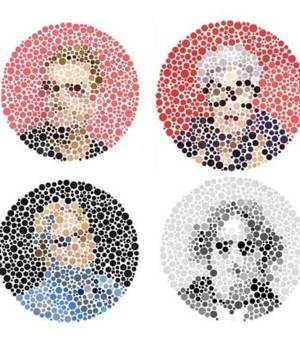
Can you spot all 4 famous faces in these quirky images we created to celebrate Colour Blind Awareness Day, on 6 September 2018?
We developed the images of famous glasses wearers in the style of the Ishihara plate test, which is used to identify colour vision deficiency.
Despite not having a direct impact on health and wellbeing, colour blindness affects almost 3 million Brits, with many not even aware that they suffer from it.
Famous faces including Elton John, Iris Apfel, Bono and John Lennon have been hidden in the spotted pictures, which were first developed in 1917 by Dr. Shinobu Ishihara, a professor at the University of Tokyo, to test for red-green colour deficiencies.
Colour blindness is the difficulty distinguishing between red and green, and blue and yellow. It is not a harmful condition and the majority of those who possess it adapt to the deficiency. Colours often appear much duller than they would to people with normal vision and they can find it hard to tell the difference between shades of purple, red, orange, yellow, brown and green.
Notable people such as Keanu Reeves, Eddie Redmayne and Prince William have confessed to being colour blind, with Mark Zuckerberg said to have chosen Facebook’s blue logo as it was easier to distinguish.
The condition is much more common in males, affecting around one in 12 men versus one in 200 women as it is a genetic and hereditary condition passed through the X chromosome.
Stephen Hannan, Clinical Services Director at Optical Express
“Although a harmless condition, we want to raise awareness of just how common colour deficiency can be and stop it being overlooked in schools, the workplace and everyday life. Removing the stigma and providing greater information on the condition will help those who struggle to distinguish between certain colours lead a normal and unrestricted life.
“Something as simple as providing reading, learning and educational materials in different colours means that those who struggle to distinguish between certain colours can benefit from the same support and opportunities as everyone else. Big progress has been made in this area since 2016, when the Department for Education and the Government Equalities Office recognised colour blindness as a Special Educational Need and a disability.
“Typical vision tests don’t check for colour vision deficiency; however, if you are struggling to see the famous faces in our Ishihara test and think you may be colour blind, your optometrist can take you through a longer version of the Ishihara test or a colour arrangement task to diagnose the severity of your case.
“As well as diagnosing colour deficiency, our optometrists are able to identify the need to prescribe glasses, contact lenses or make a recommendation relating to refractive surgery, helping improve vision and quality of life for people of all ages.”
Book an eye test